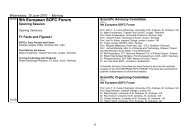European Fuel Cell Forum 2011
European Fuel Cell Forum 2011
European Fuel Cell Forum 2011
You also want an ePaper? Increase the reach of your titles
YUMPU automatically turns print PDFs into web optimized ePapers that Google loves.
�<br />
�<br />
<strong>European</strong> <strong>Fuel</strong> <strong>Cell</strong> <strong>Forum</strong> <strong>2011</strong> 28 June -1 July <strong>2011</strong>, Lucerne Switzerland<br />
A0203<br />
<strong>Fuel</strong> <strong>Cell</strong> Research Programme and Activities<br />
in South Korea<br />
Jaeyoung Lee<br />
Ertl center for Electrochemistry and Catalysis/RISE<br />
School of Environmental Science and Engineering (SESE),<br />
Gwangju Institute of Science and Technology (GIST)<br />
261Cheomdan-Gwagiro, Buk-gu, Gwangju 500-712 / South Korea<br />
Tel.: +82-62-715-2440<br />
Fax: +82-62-715-2434<br />
jaeyoung@gist.ac.kr<br />
Abstract<br />
In this talk, I shall intend to introduce the activity of Korean government, research<br />
institutes, universities and companies in fuel cells research and developments on behalf of<br />
a lot of excellent scientists and engineers in South Korea. During last 10 years, we have<br />
very much focused on the commercialization of fuel cells in various industrial fields and are<br />
showing relevant results from demonstrations of fuel cells. Of late, the national program is<br />
also providing the environment for continuous research of basic science to discover<br />
breakthrough technologies.<br />
Worldwide <strong>Fuel</strong> <strong>Cell</strong> & Hydrogen Programs 2 A02 - 3/3<br />
�<br />
�<br />
<strong>European</strong> <strong>Fuel</strong> <strong>Cell</strong> <strong>Forum</strong> <strong>2011</strong> 28 June -1 July <strong>2011</strong>, Lucerne Switzerland<br />
A0401<br />
Improvement of PEMFC Stack Components<br />
For Commercializing Residential CHP Systems<br />
Haruhiko Adachi<br />
Tokyo Institute of Technology<br />
2-12-1, I1-23, Ookayama, Meguro-ku<br />
Tokyo 152-8550 / Japan<br />
Tel.: +81-3-5734-2553<br />
Fax: +81-3-5734-2376<br />
adachi.h.ab@m.titech.ac.jp<br />
Abstract<br />
In Japan, thirteen thousand of PEMFC CHP systems (ENE-FARM) have been marketed<br />
for residential uses by FY2010, but a significant cost reduction is required for the fullfledged<br />
commercialization. Manufactures of membranes and systems, fuel suppliers and<br />
research institutes joined the ROBUST Project that was funded by New Energy and<br />
Industrial Technology Development Organization (NEDO) during FY2005-FY2009. The<br />
objectives of this project were to improve reliability and robustness of the PEMFC stack<br />
components, which contribute to simplification and cost-reduction of the whole CHP<br />
system.<br />
Asahi Kasei E-materials, ENEOS <strong>Cell</strong>tech (Sanyo Electric before FY2007) and Nippon Oil<br />
made efforts to improve the reliability of MEAs by using newly developed PFSA<br />
membranes. The period to sudden degradation of the membrane was extended 20-fold.<br />
The cell voltage decay rate of the improved MEA was reduced to 1.6µV/hour under a nearsaturated<br />
humidification. The initial cell voltage ascended up to 770mV @ 0.2A/cm 2 under<br />
the condition of Tcell=85°C, Tda=60°C, Tdc=75°C. Asahi Glass, Panasonic and Tokyo Gas<br />
made efforts to increase the robustness of MEAs by using newly selected PFSA polymers.<br />
Under the condition of Tcell=80°C, Tda= Tdc=65°C as well as under the saturated<br />
humidification (Tcell=Tda=Tdc=65°C), the initial cell voltages ascended up to 780mV @<br />
0.16A/cm 2 . The cell voltage decay caused by start and shutdown cycles was also reduced<br />
to 2µV/cycle. The operation of a 4-cells stack using newly developed MEAs verified the<br />
possibility to obtain recovered hot water of 80-85°C and the cell voltage of 770-780mV.<br />
During a WSS (weekly start & shutdown) operation of 2,600 hours that followed a<br />
continuous operation of 4,000 hours, it was possible to reduce the cell voltage decay rate<br />
to 1.5µV/hour. Injection of 0.5ppm SO2 or 1ppm H2S into cathode caused a larger and<br />
irreversible cell voltage drop especially under higher temperature and lower humidity<br />
conditions. Addition of temporary over-humidification (Tcell




